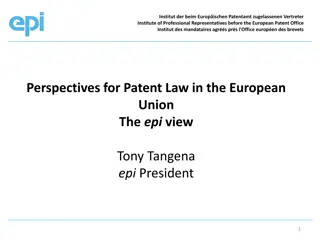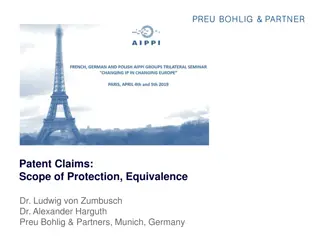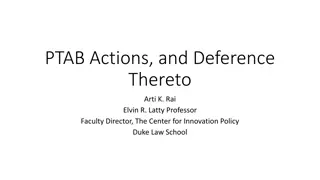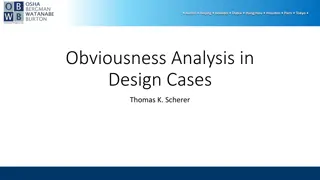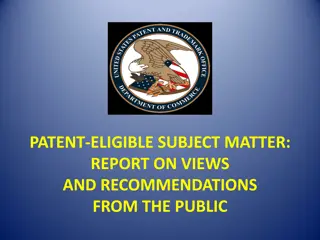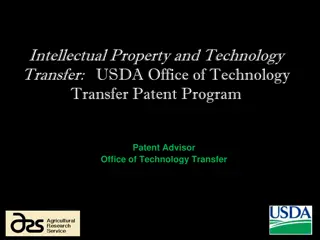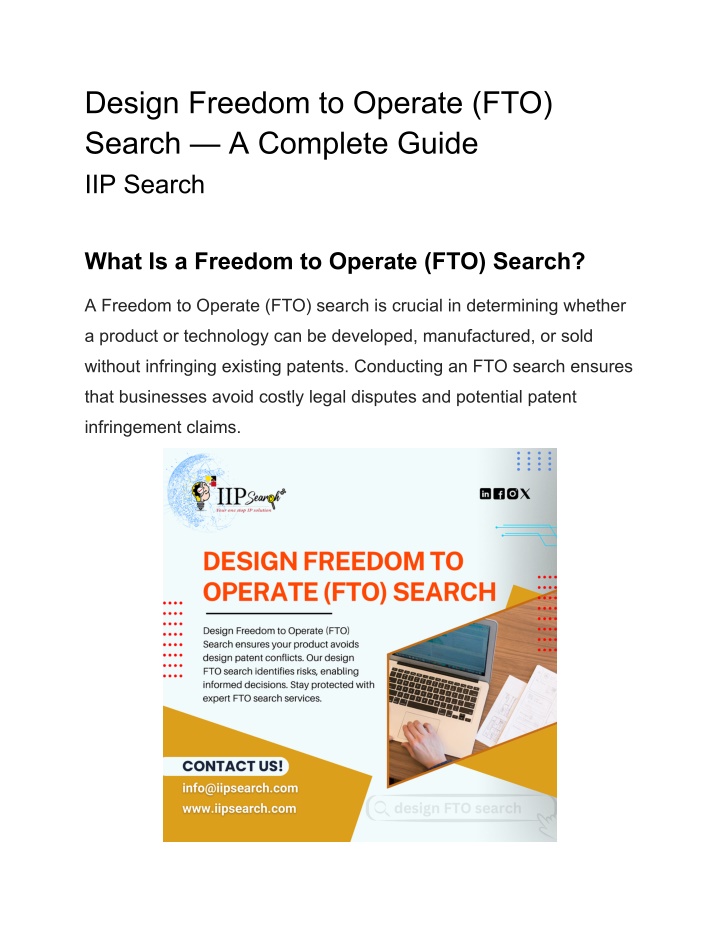
Design Freedom to Operate (FTO) Search | The Patent Experts
A Freedom to Operate (FTO) search is essential for businesses developing new products, ensuring they donu2019t infringe existing patents. This guide explores the key steps in conducting an FTO search, from defining scope to analyzing the patent land
Download Presentation

Please find below an Image/Link to download the presentation.
The content on the website is provided AS IS for your information and personal use only. It may not be sold, licensed, or shared on other websites without obtaining consent from the author. If you encounter any issues during the download, it is possible that the publisher has removed the file from their server.
You are allowed to download the files provided on this website for personal or commercial use, subject to the condition that they are used lawfully. All files are the property of their respective owners.
The content on the website is provided AS IS for your information and personal use only. It may not be sold, licensed, or shared on other websites without obtaining consent from the author.
E N D
Presentation Transcript
Design Freedom to Operate (FTO) Search A Complete Guide IIP Search What Is a Freedom to Operate (FTO) Search? A Freedom to Operate (FTO) search is crucial in determining whether a product or technology can be developed, manufactured, or sold without infringing existing patents. Conducting an FTO search ensures that businesses avoid costly legal disputes and potential patent infringement claims.
FTO searches are particularly important in industries where patents play a significant role, such as pharmaceuticals, biotechnology, software, and manufacturing. Understanding the competitive landscape allows businesses to make informed decisions, reducing financial and legal risks. Why Conduct an FTO Search? Performing an FTO search helps businesses mitigate risks and make informed strategic decisions. It provides insights into existing patents and identifies potential roadblocks in product development. This proactive approach safeguards investments and fosters innovation. Case Study: Pharmaceutical Industry A pharmaceutical company developing a new drug must ensure that it does not infringe upon existing patents. In 2018, a biotech firm faced a multi-million-dollar lawsuit because it failed to conduct a thorough FTO search before launching its drug. The legal battle delayed product release and resulted in substantial financial losses. Key Steps in an FTO Search 1. Define the Scope Start by outlining the product, technology, or process that needs evaluation. Understanding the technical and commercial aspects
helps in refining the search strategy. Clearly defining the scope ensures that the FTO search remains focused and relevant. 2. Identify Relevant Patent Databases Use reputable patent databases like: USPTO (United States Patent and Trademark Office) Covers U.S. patents and applications. WIPO (World Intellectual Property Organization) Provides international patent data. EPO (European Patent Office) Focuses on European patents. Google Patents and Espacenet Offer free access to global patent databases. A comprehensive search across these databases helps in identifying relevant patents worldwide. 3. Conduct a Keyword and Classification Search Employ relevant keywords and patent classifications to narrow down the results. Use variations of industry-specific terms to ensure an exhaustive search. Patent classification systems, such as the International Patent Classification (IPC) and Cooperative Patent
Classification (CPC), help categorize patents based on their technical fields. 4. Analyze the Patent Landscape Review identified patents and assess their claims. Determine if they pose a risk to the intended product or technology. This analysis provides insights into existing technologies and potential workarounds. 5. Evaluate Patent Legal Status Check whether the identified patents are active, expired, or pending. Understanding their legal status helps in determining the level of risk involved. An expired patent may no longer pose a threat, while a pending application may require continuous monitoring. 6. Seek Professional Advice Consulting a patent attorney or an intellectual property (IP) expert ensures accurate interpretation of search results. Legal professionals provide strategic guidance on potential risks and solutions. Case Study: Automotive Industry An electric vehicle (EV) startup aimed to introduce a new battery technology but faced potential patent infringement issues. By conducting an extensive FTO search, the company identified a set of patents that overlapped with their innovation. Their legal team
negotiated licensing agreements with patent holders, allowing them to proceed without legal challenges. Benefits of an FTO Search Avoids Legal Disputes By identifying potential infringements early, businesses can take preventive measures to avoid costly lawsuits. Legal battles over patent rights can drain financial resources and damage a company s reputation. Enhances Innovation Strategy Understanding the patent landscape allows companies to innovate while steering clear of legal conflicts. Companies can design around existing patents, creating unique and legally viable solutions. Saves Time and Resources An FTO search prevents businesses from investing in products that may face legal challenges later. Companies can allocate resources efficiently and avoid costly redesigns. Provides Competitive Insights Examining competitors patents offers valuable insights into industry trends and technological advancements. Understanding where
competitors are focusing their innovations can help businesses refine their strategies. Challenges in Conducting an FTO Search Patent Complexity Deciphering patent claims and legal terminology can be challenging for non-experts. Patent language is often technical and requires expert interpretation. Hidden Risks Some patents may not be easily detectable in public databases, requiring deeper investigation. Companies must monitor new patent filings and updates regularly. Global Considerations Patent laws vary across countries, making it essential to conduct international searches for global operations. A product may be free to operate in one country but restricted in another. Best Practices for Conducting an FTO Search Hire experienced patent professionals Their expertise ensures comprehensive search and accurate analysis. Regularly update FTO searches The patent landscape evolves, requiring ongoing monitoring.
Consider alternative strategies If potential infringement is detected, companies can pursue licensing, cross-licensing, or redesign strategies. Document findings Keeping detailed records of search results and legal opinions aids in future risk assessment. Example: Technology Industry A software company developing AI-driven analytics tools conducted an FTO search to avoid infringing existing AI patents. The search revealed a patent held by a competitor that closely resembled their algorithm. Instead of halting development, the company collaborated with the patent holder, leading to a mutually beneficial partnership. Conclusion A well-executed Freedom to Operate (FTO) search is essential for businesses aiming to launch new products without legal risks. By following a structured approach, companies can safeguard their innovations, optimize investment decisions, and stay ahead in a competitive market. Always seek professional assistance to ensure a thorough and legally sound FTO analysis.
Need Expert Assistance? Ensure your business operates without legal hurdles. Conduct a professional Freedom to Operate (FTO) search today! Learn more here: Design Freedom to Operate Search.




